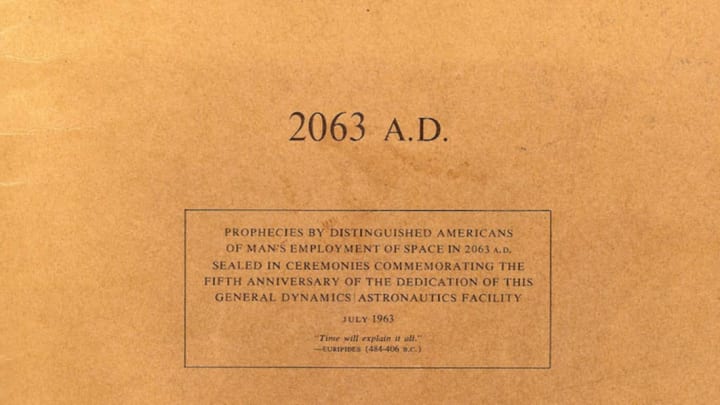According to the International Time Capsule Society at Oglethorpe University in Atlanta, there are approximately 10,000 time capsules in the world. Unfortunately, they also estimate that no one remembers where 9,000 of them are buried. Here's what happened to seven of these lost collections.
1. State secret
Even though most time capsules contain little of monetary value, there's always that chance that someone will deface or damage them just to be a jerk. The City of Wilkinsburg, Pennsylvania, developed an ingenious plan to prevent such vandalism when they decided to inter a time capsule in 1962. They elected a special committee to decide where the capsule should be buried and were then instructed to keep the location a secret. The men kept their word all right—perhaps a little too well.
Twenty-five years later, when the capsule was supposed to be dug up for the city's 100th anniversary in 1987, almost all of the committee members had died and none had passed on the time capsule's secret location. Only one member of the committee was still alive, and he couldn't remember where it was. To this day, the capsule is still hidden somewhere underneath the city.
2. Lost in space?
To commemorate the fifth anniversary of their San Diego headquarters, General Dynamics Astronautics placed a time capsule inside a concrete vault in 1963. Inside the capsule was a small book titled 2063 A.D., named for the year they intended to retrieve the capsule. The book was a series of interviews with politicians, military personnel, and those in the space program, offering educated predictions about life 100 years in the future.
For example, Brigadier General Irving Branch (USAF), suggested the moon would have a population of 100,000 by 2063; Mars' colony would be a quaint town of only 10,000. John Glenn thought we would have an anti-gravity rocket propulsion system that would take us further into space than we could even imagine possible. And then-Vice President Lyndon Johnson felt man would be able to control the weather, have the capability for global communications, and that commutes between space stations and planets would be an everyday event.
Unfortunately, when the General Dynamics building was torn down in the late-1990s, the time capsule could not be found and has been presumed destroyed. But all is not lost—the forward-thinkers of 1963 had the bright idea of printing around 200 copies of 2063 A.D. and distributing them to select universities all over the United States.
3. Signed, sealed, not delivered
The Bicentennial Wagon Train of 1976 consisted of 50 horse-drawn wagons, one for each state, traveling across the country following the traditional wagon trails that led the pioneers out West. Only this time, the travelers were going in the opposite direction—from the West Coast, back to Valley Forge, Pennsylvania, where they would take part in a huge Bicentennial celebration. Along the way, passing through towns big and small, they collected the signatures of a reported 22 million Americans. These signatures were placed inside a time capsule to be buried at a ceremony presided over by President Gerald Ford himself. However, moments before the big event, it was discovered that the capsule had been stolen from the back of the van, never to be seen again.
4. Resurfacing
Every once in a while, a supposedly long-lost time capsule will crop up again—like one of the two capsules that were supposed to be buried in 1953 as part of the centennial celebration of the Washington Territory (now the state of Washington). While the larger capsule was interred as planned, the smaller one was inexplicably left in a fifth floor storage room of the state Capitol building. It had been packed away inside a nondescript crate and would probably still be there today were it not for an earthquake that damaged the Capitol in 2001. While cleaning out the storage room, workers assumed the lead container held old mimeograph fluid. As they began to haul the crate out of the room, they noticed writing on the side that told them what they had really found.

In a risky move, the capsule was placed back into storage at another facility until the repairs to the Capitol building were completed. All went smoothly this time around, and the capsule was ultimately buried next to its big brother on the Capitol grounds in 2005. To ensure this type of thing doesn't happen again when the capsules are supposed to be opened in 2053, a small brass plaque was placed on the spot where they're buried, and a document describing the location was sent to the state's archives in both Olympia and Cheney, Washington.
5. Repeat offenders
The city of Corona, California, holds the all-time record for time capsules lost by one organization. As part of Corona's 1985 Labor Day celebration, 17 time capsules buried since the 1930s by local high school classes were meant to be retrieved. City workers began tearing up the concrete around civic hall where the first capsule was thought to be, but they came up empty. So they tried the next spot. Nothing. In all they dug 17 holes, tore up a lot of concrete, and found zero time capsules.
6. Photo proof

In 1991, officials thought it would be a good idea to designate the site of the capsule with a marker as part of the dam's 50th anniversary. There was just one problem: no one knew exactly where the capsule was anymore. They did recall that a plaque describing the location of the capsule had been sent to the state Capitol for safe-keeping—but no one at the Capitol building had ever seen or heard of such a plaque. Almost out of ideas, they started looking through the dam's archives and discovered the photos from the ceremony, including the one of the two girls cutting the ribbon. Thanks to the photographic evidence, they were finally able to track down the location of the capsule and put a sign on top.
7. It ain't rocket science

